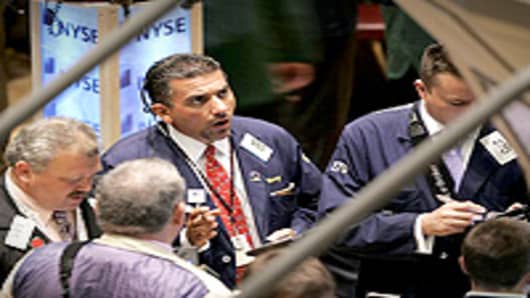As the Fed's November meeting approaches, the markets are increasingly concerned that the central bank is cooking up inflation with its new easing plan.
Stocks Tuesdaylooked to be treading water ahead of the Nov. 3 Fed meeting, as they finished just slightly higher on the day. But a sizeable sell off in the bond market wiped out some of the gains made since the Fed waved on the idea of a new quantitative easing program at its Jackson Hole symposium in late August.
"The 10-year yield today closed at the level it closed at on Aug. 27 — 2.65 percent...so this is now the danger for the Fed. They laid out QE, and the 10-year yield that they tried to suppress wasn't down. It was before, but it's not any more because of the inflation danger they now created," said Peter Boockvar, equities strategist at Miller Tabak.
"And the 30-year yield is even 30 bps higher than it was on Aug. 27," Boockvar added.
The surprise negative yield in Monday's 5-year TIPS auction got the attention of stock traders, who have been focusing on the parade of comments about rising commodities costs coming from companies' earnings reports.
The $10 billion in Treasury Inflation Protected Securities were in such demand that investors bought them with a negative yield of 0.55 percent, the first negative TIPS yield ever. TIPS investors bet that inflation will increase, and they stand to collect a premium based on the increase in inflation when the bonds mature.
The Fed has said one of its concerns is that inflation is too low, and the TIPS auction shows investors now believe the Fed will win the battle against deflation and as a result, spark inflation.
Hot Commodities
Kimberly-Clark Tuesday was one of the most recent companies to report on the pressure from rising commodities prices. The consumer products company reported a 19 percent decline in net income and cut its forecast for the year, in part on the rise in costs.
The company said the costs for pulp, polymer resin and oil-based materials jumped by $265 million in the quarter, the largest quarterly cost increase in its history. Analysts have been watching this quarter as industrial companies, like Ingersoll-Rand , comment on rising metal prices and food companies, like McDonald's, say they will have to raise prices because of increasing food prices.
"Commodities are going a lot higher," said Boockvar. "If you look at the increase in the S and P, it's basically matched by the increase in the (Reuters Jefferies) CRB index. If you want to measure the market in inflation terms, with the CRB as a measure, inflation is up by the same amount, so we're really no better off...if you give someone a 5 percent raise, they feel better, but if the costs of living goes up by the same amount, it's like running in place."
What Else to Watch
Companies reporting earnings Wednesday include Procter and Gamble, a good company to watch for input costs. Other companies reporting include Northrop Grumman, General Dynamics, Dr. Pepper Snapple, Praxair, Sealed Air, Thermo Fisher, Comcast, Deutsche Bank, Legg Mason and SAP. ConocoPhillips and Allegheny Energy also report ahead of the open. Norfolk Southern, Allstate, Symantec, Flextronics, and Ryland report after Wednesday's bell.
Boockvar said rising inflation will hit stocks differently. Commodities producers will benefit.
"Certain stocks are an inflation hedge," he said, but noted retailers, on the other other hand, could be negatively impacted.
Wednesday's data includes durable goods at 8:30 a.m. and September new home sales at 10 a.m.
The Treasury auctions $35 billion in 5-year notes, following Tuesday's auction of $35 billion in 2-year notes which drew a record low yield of 0.4 percent. Thirty-year bonds fell 1-18/32 with the yields rising to 4 percent. The 10-year fell 21/32, and its yield climbed to 2.65 percent from 2.57 percent Monday.
RBS Treasury strategist John Briggs said he sees room for more consolidation.
"I think what we're seeing is we have a market that's very long. People are looking to reduce risk into next week," he said. In the coming week, mid-term U.S. elections are held Tuesday; the Fed statement is issued Wednesday, and the October employment report is released Friday.
"I think people are trying to hold on until month end to reduce exposure to QE and to reduce risk ahead of a very busy week," he said.
He expects the 5-year auction to do well because the auction can serve as a "liquidity center" for investors looking to build sizeable positions.
"Technically, the market looks like it's in consolidation phase. You can make an argument the market is going to be on a lot better footing going into that (Fed) event," Briggs said.
The Fed's QE program is expected to include the purchase of Treasury securities, which in theory reflates assets and pushes down lending rates. Since late August, the Fed's hint at easing has driven the dollar lower and pumped up stocks and commodities.
While the markets have responded to the promise of more easing, traders and analysts, like Boockvar, have increasingly questioned the reasoning for it.
"They have to be careful what they wish for," Boockvar said. "Why do you have to raise the cost of living for people who can't afford their cost of living?"
The dollar Tuesday gained 0.9 percent against the euro , finishing at $1.3852, and it gained about the same amount against the yen . The dollar lost 0.7 percent against sterling , after the U.K. reported better than expected GDP.
The Dow rose to 11,169 Tuesday, and the S&P 500 increased less than a point, holding at 1185, a key resistance level.
- Follow me on Twitter @pattidomm.
Questions? Comments? Email us at marketinsider@cnbc.com




